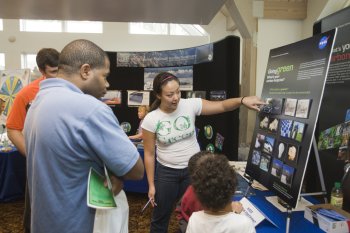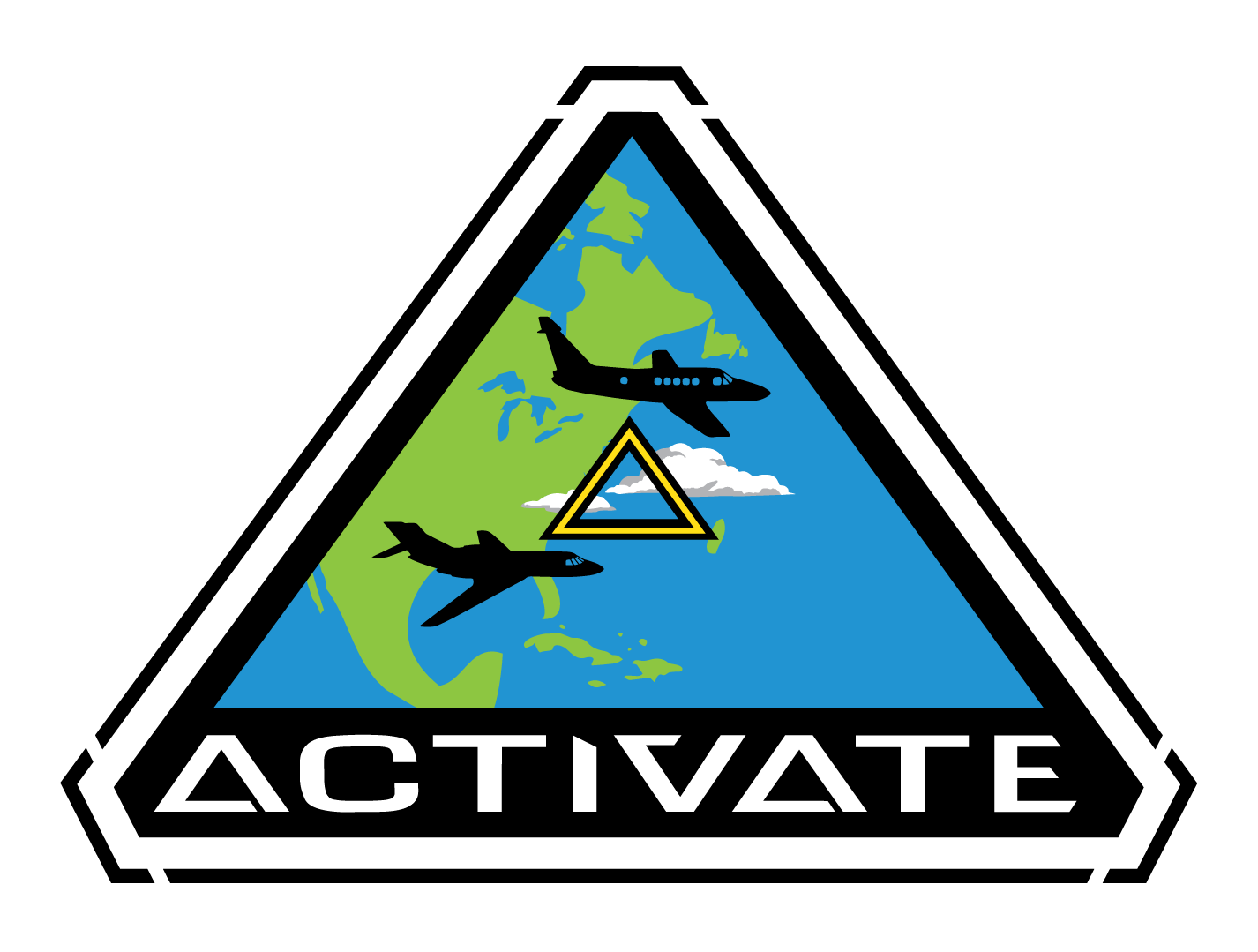Informal Education Activities
| We have developed a series of informal games to use at events that can quickly engage visitors to a NASA booth. These games are to be printed using a large format printer and then mounted to a piece of foam core. Assembly instructions and information about the game pieces are available for each game. The games can be placed on a table-top using an easel or can even be placed flat on the table so that smaller children can easily reach the pieces. The information file for each provides background info and suggested spiels for game facilitators and staffers. |  |
Please contact Jessica Taylor, jessica.e.taylor@nasa.gov
if you have any questions about the games or suggestions for improvements.
Each link given below will open its target document in a new window.
Dependent upon connection speed, some of the larger files may take several minutes to download.
1. Air We Breathe
The Air We Breathe is a picture book designed to introduce Earth’s atmosphereand its importance to life on Earth. It also introduces how the addition of newgases contributes to changing the quality of air we breathe.With an understanding of how our atmosphere works, we will begin to understandhow our activities may be contributing to some of those changes in air quality.This game aligns with the National Standards for Science that state thatkindergarten through fourth grade should begin understanding properties of earthmaterials, changes in earth and sky, as well as objects in the sky.
How to Play
Read through the Air We Breathe narrative on the story board with the student,and every time you stop at a blank, ask the student to choose which picture would be best to finish the sentence.Download the files:
- Information about the game: “Download” [PDF]
- Background to print and mount on foam core: “Download” [PDF]
- Game pieces: “Download” [PDF]
- Assembly instructions: “Download” [PDF]
2. Cloud Memory
According to the American Association for the Advancement of Science Benchmarksfor Climate Literacy, section 4-b, by the end of fifth grade, students shouldunderstand how to clouds form. The National Science Education Standards (Content Standard D)maintains that as a result of their activities in grades K-4, all students should developan understanding of properties of earth materials, objects in the sky, and changes inearth and sky. Clouds are one of those objects of study, and being able to identifynot just their properties, but also their names. This game lets students test their memory,while learning to recognize cloud names and characteristics in a fun way.
How to Play
Mix up all pictures of clouds, and attach them to the board face down.Ask the student to select two cards at a time, and if they are a pair,the student can remove the cards from the board. If they do not match,ask the student to remember the cloud types and they look like, put them back,and pick up another two cards. Repeat until all of the cards have been removed from the board.Download the files:
- Information about the game: “Download” [PDF]
- Background artwork to print and mount on foam core: “Download” [PDF]
- Game pieces: “Download” [PDF]
- Assembly instructions: “Download” [PDF]
3. Go Green
Making environmentally friendly decisions can be far reaching; recycling can preventtrash dumps from expanding, and carpooling can reduce the amount of carbon in theatmosphere. These lessons are encouraged in Science in Personal and Social PerspectivesContent Standard F of the National Science Education Standards, and in the AmericanAssociation for the Advancement of Science Benchmarks for Climate Literacy Section 7-Bon Global Interdependence, which suggest introducing care for the environment to studentsas young as kindergarten through second grade. This game reinforces that students canmake “green” decisions, and that each decision, no matter how small, does make a difference.
How to Play (Original Version with green on the background)
Attach all of the game pieces to their corresponding photos on the board.Ask the student to look at each pair of pictures and decide which picture representsa more “green” decision. They remove their “green” choice from the board.If it’s the right answer, the photo behind will be shaded in green; the lessgreen option is shown in black and white. Watch out because the green image canpeak through if the pieces aren’t lined up just right.
How to Play (Updated Version)
We have also provided a blank background and additional game pieces.This background can be used with all of the game pieces and the facilitator willjust indicate which answer is the right answer. Another option would be to put asticker or star on the back of the right answer so that guests will be able toturn the piece over and know when they have chosen the right answer.
Download the files:
-
- Information about the game: “Download” [PDF]
- Background artwork to print and mount on foam core: “Download” [PDF – 45MB]
- Game pieces: “Download” [PDF]
- Assembly instructions: “Download” [PDF]
- Version 2 – additional game pieces: “Download” [PDF – 33MB]
4. Weather Versus Climate
Weather and climate are among the most dynamic and complex systems on Earth,systems in which humans are not just affected, but also play a role.The National Research Council’s Committee on Science Education Standards andAssessment and the American Association for the Advancement of Science Benchmarksfor Climate Literacy, section 4-b suggest that students begin learning how tolog weather and identify patterns in climate as soon as early elementary school.One of the foundational concepts in this area of Earth science is understandingthe difference between weather and climate, and this interactive game providesserves as a vehicle for educators, both formal and informal, to introduce thedifferences between weather and climate.
How to Play
Divide images into color-coded sets and work through each set one at a time.Have the students decide which image represents weather and which represents climate,and attach to the board under the appropriate category.
Download the files:
- Information about the game: “Download” [PDF]
- Background artwork to print and mount on foam core: “Download” [PDF]
- Game pieces: “Download” [PDF]
- Assembly instructions: “Download” [PDF]
5. Snapshots of Earth
NASA has the unique ability to view Earth from space, from satellites and thespace shuttle to the International Space Station (ISS). Beginning with the Mercurymissions in the early 1960s, astronauts have taken more than 700,000 photographsof Earth. Today, the ISS continues NASA’s tradition of Earth observation from human-tended spacecraft.The ISS provides an excellent stage for observing most populated areas of the world.Satellite instruments make beautiful images of our home planet as well.NASA hosts a fleet of nearly 13 Earth-observing satellites and numerous instrumentsto monitor Earth’s surface and atmosphere.
The images in this game convey the thrilling perspective of Earth that can be captured only from beyond our planet’s atmosphere.To enjoy more images of Earth from space, visit http://eol.jsc.nasa.gov/ or http://earthobservatory.nasa.gov.
How to Play
Place all of the photos/images on the table face up (velcro side toward the table).Have the student read the captions on the board and choose the best image to match each caption.We used printable labels on the velcro side as a hint to help the game facilitator know the right answer.A lot of students will turn the cards over and accidentally see this hint, so these labels can be omitted if you prefer.
Download the files:
- Background artwork to print and mount on foam core:“Download” [PDF]
- Game pieces: “Download” [PDF]
Resource Links for Teachers
Resource Links for Kids
- Cloud Teller (2MB, PDF)
- Weather Calculator

